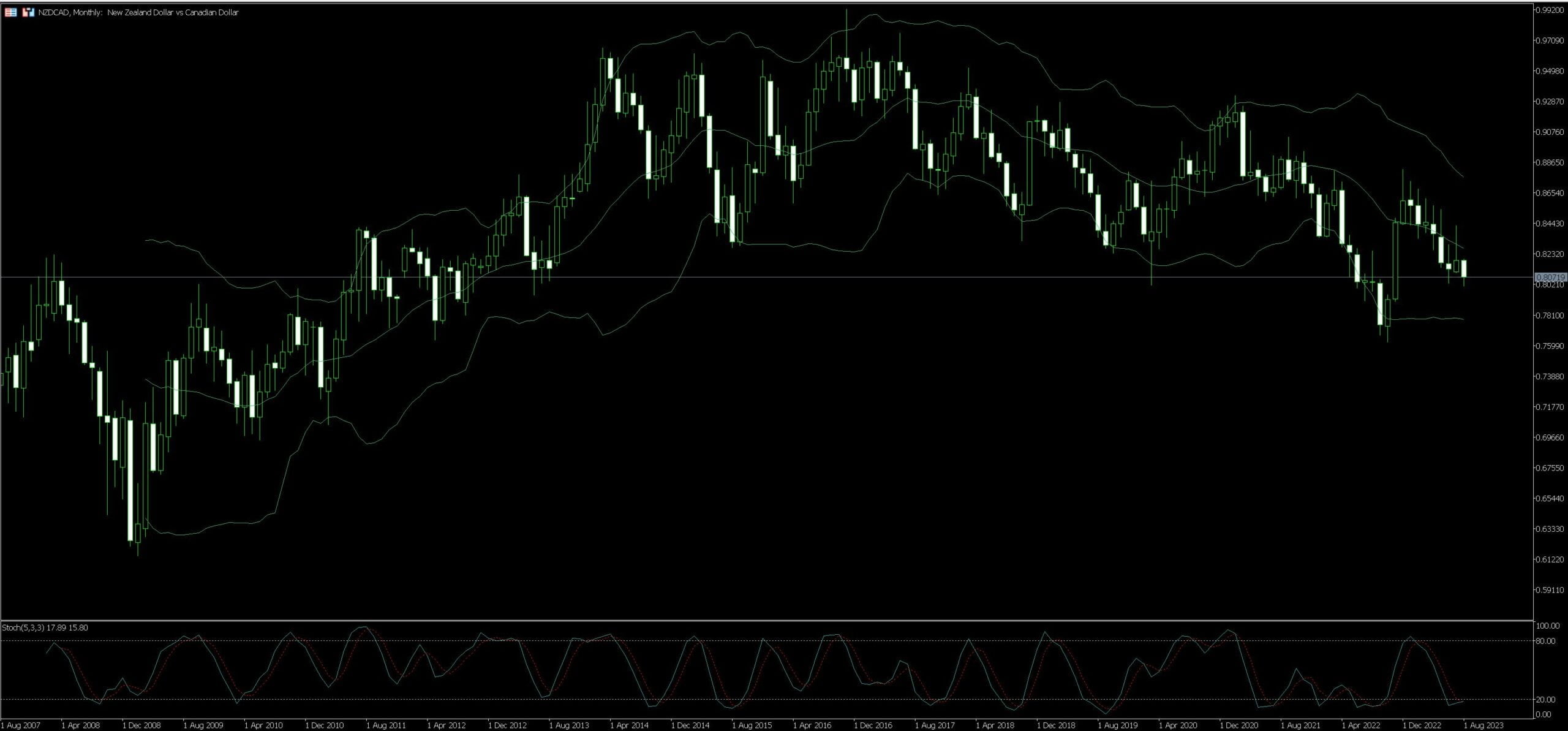Live Chart Of NZD/CAD
1. Understanding NZD/CAD Trading
NZD/CAD, often referred to as the ‘Kiwi-Loonie’ in Forex circles, represents the currency pair comprising of the New Zealand Dollar (NZD) and the Canadian Dollar (CAD). These currencies belong to two different economies greatly affected by the fluctuations in commodity prices. While the NZD is closely tied to dairy produce, the CAD is significantly influenced by crude oil prices.
This juxtaposition makes NZD/CAD a fascinating pair to trade. However, understanding the intricacies of NZD/CAD trading involves a deep look into the economic health of both New Zealand and Canada. When the economy of New Zealand shows signs of growth, it drives up the NZD while a growth in the Canadian economy strengthens the CAD.
Mastering NZD/CAD trading involves keeping a close tab on the economic indicators of both countries. The GDP reports, consumer price index data, unemployment rates and central bank decisions play a pivotal role in shifting the NZD/CAD dynamics.
Pay special attention to the commodities price chart – it holds relevance here more than many other currency pairs. The price trajectory of crude oil and dairy products could impact your NZD/CAD trade. Hence, a trading strategy for this pair must include these significant economic indicators. Keeping a keen eye on geopolitical occurrences that might affect the dairy and crude oil prices is also beneficial.
Embrace technical analysis – it is crucial in anticipating short-term price movements effectively. Utilizing tools like Moving Averages, Bollinger Bands, and RSI can ease your navigation through the volatile Forex market.
Managing risks properly – as with every other financial market, trading NZD/CAD comes not without risks. Solid risk management strategies can diminish potential losses. Using stop losses wisely, risking only a fraction of your trading capital, and utilizing leverage judiciously can safeguard your trades.

By combining careful observation with the right trading strategies, understanding NZD/CAD trading becomes less daunting and more rewarding. Your knowledge of the foreign exchange market broadens, and you could make informed decisions with increased confidence.
1.1. Origin of NZD/CAD Pair
NZD/CAD, born out of a unique and rich trade relationship between New Zealand and Canada, constitutes the New Zealand Dollar (NZD) and Canadian Dollar (CAD). Their intertwined stories stretch back to the late 19th century when both countries were developing as autonomous entities within the British Empire. Trade links were established, and currencies intermingled: the New Zealand Pound, then the Dollar in 1967, and Canada’s very own Dollar from 1858. The formation of modern-day NZD/CAD was shaped primarily by the globalization of financial markets in the 1970s and 1980s. As these international trade flows and investment networks grew more robust, the demand for cross-currency pairs, exemplified by NZD/CAD, also saw a significant upsurge. This resulted in a fluctuating exchange rate reflecting the economic fortunes of both nations. This pairing captured the multifaceted impacts of economic policies, monetary shifts and raw materials demand, making it one of the sought-after assets in the forex market.
Peeling the layers unveils a more complex reality – the NZD/CAD pair is a blend of unique correlations that harmonize the Forex market. New Zealand, known for its gargantuan agricultural sector, particularly in dairy products, sees its currency, the NZD, closely tied to the commodities market. Meanwhile, Canada harnesses economic power from its abundant natural resources, particularly crude oil, creating a strong correlation of the CAD to global oil prices. This coupling mirrors the intertwined destinies of two geographically distant yet economically bonded regions. It is this intriguing blend of commodity prices, monetary policies and trade flows that determine the ebb and flow of the NZD/CAD pairing, offering myriad opportunities for seasoned and nascent traders alike.
1.2. Economic Factors Influencing NZD/CAD Value
Navigating through the complex world of forex trading demands a deep understanding of the myriad economic factors at play. To grasp how the NZD/CAD exchange rate shifts, pay attention to a variety of economic variables that may significantly affect the value of these currencies.
One of the pressing influences on this currency pair lies in interest rate differentials. The Reserve Bank of New Zealand (RBNZ) and the Bank of Canada (BoC) each set their respective nation’s interest rates. Interest rates are a primary driver of currency values; the higher the rate, the more attractive the currency becomes to foreign investors seeking returns.
Additionally, commodity prices play a significant role in shaping the NZD/CAD value. The New Zealand dollar (NZD) is considered a ‘commodity currency’ because New Zealand is a major exporter of goods such as dairy and timber. Similarly, the Canadian dollar (CAD) is heavily influenced by the pricing of commodities like oil and gas, which Canada exports in large quantities.
Further still, geopolitical events can cause substantial volatility in this forex pair. News of trade agreements, regional instability, or major political shifts can quickly change traders’ perception of a nation’s economic prospects.
Economic indicators of both countries, such as GDP growth rate, employment statistics, inflation data, and trade balances, also sway the NZD/CAD value. Traders are always watchful of these indicator announcements as they provide insight into the strength and health of each economy.
Finally, a nuanced understanding of market sentiment shapes the NZD/CAD value. During periods of global risk aversion, currencies of economies perceived to be stable or ‘safe,’ tend to appreciate. Conversely, in times of global risk appetite, investors may seek higher-yielding, ‘riskier’ currencies. Traders analyzing the NZD/CAD currency pair should keenly observe international news and global economy trends to gauge market sentiment.
2. NZD/CAD Trading Strategies

The New Zealand dollar and Canadian dollar pair, known as the NZD/CAD, offers several unique opportunities to traders. It provides a gateway to effective global diversification well suited to traders familiar with developed markets. As with any currency pair, understanding the fundamental factors impacting both currencies will guide any trading strategy.
On one hand, the NZD is heavily influenced by factors such as the health of the global dairy market and the overall state of the Asia-Pacific region’s economies. Understanding these dynamics allows traders to anticipate movement in the NZD.
On the other hand, the CAD is a true ‘commodity currency’, greatly affected by the global oil market. Increases in oil prices often translate into a stronger CAD, thanks to Canada’s substantial oil reserves and exports.
A common NZD/CAD trading strategy uses fundamental analysis, with its basis in these economies’ indicators. Another strategy is the technical analysis route, taking advantage of historical price patterns, trends and levels of support or resistance.
Furthermore, while using either strategy, it is crucial to manage risk effectively. Every effective NZD/CAD trading strategy incorporates elements of risk management, such as setting stop-loss and take-profit levels, effectively managing leverage, and diligently tracking all open positions.
Also, notable is the relatively low trading volume of this pair. This can present advantages and disadvantages. Traders may find favorable pricing during volatile periods, yet may also find it harder to exit positions at times of reduced market liquidity.
While both currencies can be influenced by global events’ risk sentiment, they often react differently to these developments. So, despite their shared status as commodity currencies, they provide opportunities for traders to profit from their unique responses to global economic events.
Trading the NZD/CAD involves a solid understanding of these fundamentals, as well as a disciplined approach to risk management. The careful observation of global events, forex news, and market analysis can all contribute significantly to a successful NZD/CAD trading strategy. Understanding these complexities makes it a truly engaging pair for trading and offers potential rewards for those willing to navigate its intricacies.
2.1. Fundamental Analysis
In the realm of Forex trading, fundamental analysis stands as a cornerstone for informed decision making. This method bubbles down to evaluating multiple economic factors – both macro and micro – that influence the value of a currency pair, such as NZD/CAD. At its core, the two major economies, New Zealand and Canada, form the crux of the analysis.
A close examination of economic indicators helps traders predict potential price movements. Key figures such as interest rates announced by the Reserve Bank of New Zealand (RBNZ) or the Bank of Canada (BoC), GDP growth rates, unemployment rates, or customer price index (CPI) data are put under scrutiny. An uptick in any of these could signify a bullish trend while a downtick might denote a bearish trend.
Political events also have a say in the game of currency exchange rates. Elections, changes in government policies, diplomatic relations between countries, and geopolitical unrest strongly sway a currency’s position. For instance, the New Zealand dollar may surge or slump in the face of looming political transitions. Similarly, the Canadian dollar could fluctuate upon implications of certain policies.
Trade relations, as another critical facet, add to the complexity of fundamental analysis. Since both New Zealand and Canada are major commodity exporters, shifts in their export and import chains can potentially tilt the NZD/CAD balance.
Further down the rabbit hole, commodity prices come into play. An increasing trend in dairy prices (New Zealand’s primary export commodity) would generally be beneficial for the NZD, while a rise in oil prices (Canada’s chief export commodity) could bolster the CAD.
But wait, there’s more. Investor sentiment, shaped by global events or macroeconomic trends, provides the garnish to the fundamental analysis salad. Often, a swing in investor sentiment can undermine or override all other aspects of the analysis. In gist, keeping a finger on the pulse of the global economic landscape helps foresee changes in NZD/CAD exchange rates.
With the above information, Forex traders are aptly armed to anticipate and ride the waves of NZD/CAD currency pair through informed fundamental analysis.
2.2. Technical Analysis
Technical analysis, often referenced as a cornerstone in Forex trading, leverages statistical trend patterns extracted from historical trading data. It aims for a comprehensive understanding of market movements with an ethos to forecast near-future behaviour of NZD/CAD currency pair.
The commonly used principle in technical analysis, ‘History repeats itself’, pays homage to the patterns which emerge as a consistent response to similar stimuli. Aligning with this principle, decision-making often rests on chart patterns, moving averages, and technical indicators.
Trading charts unfold a visual story of fluctuating NZD/CAD rates over time. Candlestick, bar, and line charts feature prevalently in brightening these price trends. Candlestick charts, in particular, shadow other charts with their superior showcase of price movement intricacies.
Moving averages, on the other hand, iron out aberrant fluctuations to unearth the underlying trend. It could be simple moving averages where all data points get equal weight or exponential moving averages which deliver increased prominence to recent data points.
To further layer the analysis, traders frequently employ technical indicators. These are mathematical calculations based on volume or price to explore the volatility, trends, and momentum. From simple tools like trend lines to complex oscillator-based tools such as Relative Strength Index (RSI) or Moving Average Convergence Divergence (MACD), technical indicators represent a versatile aid in deciding the trading strategy.
Leveraging Fibonacci retracement extends another assisting hand in understanding potential support and resistance levels during a significant market movement. These levels often hold key information which guides if a trend is likely to continue or reverse.
By harnessing these components of technical analysis, traders can indeed stay a step ahead in their NZD/CAD trading journey and improve their decision-making process.
2.3. Sentiment Analysis
Sentiment Analysis holds significant relevance when trading NZD/CAD. This method involves studying the overall mood or tone of market conditions and news surroundings, which can lead to a change in the currency pair’s value. Traders, worldwide, monitor social media, economic news, political events, and other relevant channels for signs that might hint at a potential shift in trading patterns.
For instance, a positive economic report or upbeat news from New Zealand may boost the value of the NZD against the CAD, offering an excellent opportunity for traders to buy. On the contrary, a negative sentiment surrounding the Canadian economy could drop the value of CAD, urging traders to sell.
Trading platforms today offer automated sentiment analysis tools equipped with complex algorithms that track, evaluate, and compile data from hundreds of news sources alluding to the state of the economy, thus making the trading process simpler and more efficient. Traders, beginner or veteran, should harness the power of sentiment analysis to make informed decisions but certainly not without considering other key factors like fundamental and technical analysis. Under no circumstances should trading decisions be solely reliant on sentiment analysis as it’s only a part of the broader trading strategy.
Bear in mind that sentiment analysis is as vital as the trader’s understanding of how to use the information generated effectively. Optimum usage of these insights can yield fruitful results, providing an edge over others in the competitive world of Forex trading. Ignoring sentiment analysis can lead to missed opportunities and potential losses, indicating its integral role in the trading process.
Staying attuned to the market sentiment can significantly aid in decoding investor psychology, a game-changer in Forex trading. It can help traders gauge the overall trend, predict potential reversals, or validate a trade signal, thereby offering a comprehensive outlook of market conditions to navigate wisely and maximize potential earnings. Exceptional forex trading involves utilizing a combination of sentiment, fundamental, and technical analysis to make informed and effective trading decisions.
3. Managing Risk in NZD/CAD Trading
Mitigating uncertainty in NZD/CAD trading can be a daunting task, primarily when price volatility is high. However, with the right tactics and strategies, it’s manageable. A crucial element to consider while trading this Forex pair is market analysis. Traders need to familiarize themselves with both New Zealand and Canadian economic indicators. Their effect on the currency rates is something one cannot over-emphasize.
Trend identification is another significant factor. Utilizing technical analyses helps traders make decisions based on the pair’s historical data. Algorithms like Relative Strength Index (RSI), Moving Averages, and Bollinger Bands can help identify promising trading opportunities and potentially profitable trading positions.
Leveraging various risk management tools available in most trading platforms is essential. Stop-loss orders, take profit points, and limit orders ensure the trader’s exposure is limited to an acceptable risk level.
Diversification is a strategy often talked about, yet not often put into practice. Allocating one’s trading capital across multiple trades, rather than investing all capital into the NZD/CAD, can also prove beneficial in the long run.
Lastly, nothing substitutes discipline and emotional control when trading currency pairs. Making decisions based on impatience or fear usually leads to losses. It helps to follow a sound trading plan, taking a considerable amount of emotion out of trading decisions.
Being thoroughly informed and prepared strengthens a trader’s risk management capabilities when trading the NZD/CAD forex pair.
3.1. Importance of Risk Management
Trading the NZD/CAD pair requires a keen understanding of both technical analysis and fundamental market principles. However, even with these in hand, trading can turn into a coin toss if one does not understand the significance of risk management.
Risk management is indispensable given the inherent volatility in currency markets. Currency pairs like NZD/CAD often make sudden shifts based on small changes in underlying macroeconomic indicators. Without a sound risk management strategy, a trader can quickly wipe out their trading account.
Consider the consequence of setting a trade without a stop-loss order. Even a minor, unexpected move in NZD/CAD could result in substantial losses. By contrast, setting a tight stop-loss order prevents a potential disaster from unfolding by limiting the downside exposure.
Leverage is another key consideration in risk management. While leverage can amplify profits, it can similarly compound losses. Exercising prudence in leveraging trades can prevent adverse outcomes.
Additionally, risk diversification is vital. Traders can mitigate specific risks associated with the NZD/CAD pair by diversifying their trade positions across different currency pairs and asset classes.
More than just a safety net, effective risk management is a strategic tool. It could turn to survival, profitability, and longevity in trading the dynamic and unpredictable NZD/CAD pair. Successful traders understand this and use risk management to maximise their potential for success in the long term.
3.2. Risk Management Techniques
Trading NZD/CAD poses a unique set of risks given its dependence on global economic factors such as commodity prices and monetary policy decisions. All these require traders to employ sound risk management techniques. One such technique involves establishing stop-loss orders. These are designed to limit an investor’s loss on a position in a security, effectively positioning a trader to exit the trade once the market moves to a certain price unfavorable to their position.
Another significant approach is position sizing. This refers to the size of a position within a particular portfolio, or the dollar amount that a trader will risk on each trade. Reducing the position size in more uncertain and volatile market conditions can help limit potential losses.
Diversification can also be of great value, spreading investments across different financial instruments to reduce exposure to any single asset. While trading NZD/CAD, it’s important to hold positions in other currency pairs to maintain a balanced portfolio.
Fundamental analysis, thorough research into the economic conditions of New Zealand and Canada, can also be taken up to predict possible future trends of the NZD/CAD pair. This includes following news about interest rate decisions, GDP, employment figures, and political stability, which may influence the market’s direction.
Finally, the use of technical analysis tools can help confirm trading signals and foresee future price movements. Tools like moving averages, trendlines, and oscillators can provide insightful data about market patterns and trends relevant to the NZD/CAD pair.
Hence, implementing these risk management techniques while trading NZD/CAD can significantly enhance trades’ effectiveness and profitability, keeping potential losses under control.
4. Enhancing Skills in NZD/CAD Trading

Trading the NZD/CAD pair requires a keen understanding of both economies, careful application of trading strategies, and continuous skill enhancement. The New Zealand dollar and the Canadian dollar represent two diverse, commodity-driven economies. It’s worthwhile engaging in in-depth research on interest rate decisions of both the Reserve Bank of New Zealand and the Bank of Canada.
Understanding economic indicators can greatly inform trading decisions. High impact economic indicators such as the GDP, trade balance, and employment figures must be tracked meticulously. Dovetailing important macroeconomic data with specifics market nuances such as seasonal trends, can significantly improve forecasting techniques.
Deploying the correct trading strategy is paramount. A versatile trading approach blending both technical and fundamental analysis might prove beneficial in trading NZD/CAD. Factors such as chart patterns, resistance/support levels, and moving averages can be crucial. On the other hand, key economic announcements and geopolitical events can generate significant market volatility. Real-time tracking of market news and swift application of appropriate trade adjustments can offer opportunities for profit-making.
Continuous enhancement of trading skills is truly the core of successful NZD/CAD trading. The pursuit of education offers the chance to polish decision-making skills and to stay updated on best trading practices. Participating in professional trading workshops, consuming insightful material from trusted financial literature, and leveraging the vast resources available on reputable trading platforms can boost trading dexterity.
Trade psychology is also a key aspect of trading. Maintaining discipline to consistently apply a strategy despite intermittent losses and building resilience to withstand market volatility are vital parts of the trader’s journey in the NZD/CAD market. Every trade carries potential learning and can be a stepping stone to trading mastery if utilized properly. Trading the NZD/CAD successfully is indeed a journey of skill enhancement.
4.1. Education and Research
Knowledge is a trader’s first line of defence. When planning to trade NZD/CAD, immersing oneself with a strong foundational understanding and thorough research is a must. Direct investment in education resources like books, online tutorials, and webinars help to build a solid base that can prove valuable during trades. These resources enable traders to interpret forex indicators, understand principles such as support and resistance lines, and navigate the likely outcomes by leveraging historical currency pair analysis.
Beyond just reading about the fundamentals, investing time into live forex trading courses is crucial. These interactive platforms offer real-time insights into market trends and help honing decision-making skills in a volatile trading environment. Future-proof trading practices through a deep understanding of macroeconomic indicators, such as GDP, inflation rates, and employment data. A scholar of the investing sector notes, “Continuous learning and adaption is paramount to a trader’s success.”
Research is the twin pillar, complementing education. Before positioning any trade, conducting diligent market research is essential. Using a blend of technical analysis, such as chart patterns and price projection tools, coupled with fundamental analysis like economic announcements, a trader can make informed decisions. Deep historical analysis of NZD/CAD is advised to understand how this currency pair reacts to market changes. Arming yourself with robust research and broad-based education increases the chances for successful trades.
4.2. Practice and Experience
Developing proficiency in trading NZD/CAD requires careful practice and acquisition of robust experience. Opening a demo trading account allows for safe, risk-free experimentation with various strategies. Nevertheless, it’s crucial to treat the virtual capital in a demo account as real money to foster the adoption of prudent risk management habits. Combining technical analysis with fundamentals, specific to both New Zealand and Canada, can contribute to more informed decision-making.
Punctual practice on a demo account can foster a deeper understanding of how market conditions affect NZD/CAD price movements. Regularly following financial news from both countries, understanding interest rates differentials, economic data releases, and commodity price fluctuations all factor into the equation.
Experience, undoubtedly, is the best teacher in trading, fostering a nuanced understanding and the ability to understand trading’s subjective aspects. It underscores the importance of trading psychology, discipline, and risk management – aspects that cannot be fully grasped by merely digesting theoretical knowledge. Undertaking regular trades, meticulously analyzing trade outcomes, and learning from both successes and failures, takes the theoretical knowledge to a proficient level and transforms it into effective practical experience.
The intensity of one’s dedication to practice and the depth of trading experience will be significant contributors enhancing the trader’s proficiency when dealing with NZD/CAD. The journey to becoming a successful NZD/CAD trader is thus, not a destination, but an ongoing process.











